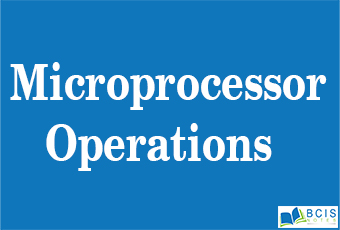
Microprocessor Operations
Operations of ALU is arithmetic as well as logical which includes addition, increment, subtraction, decrement, logical operations like AND, OR, Ex-OR, complement, evaluation, left shift or right shift. Both the temporary registers as well as accumulators are utilized for holding the information throughout the operations then the outcome will be stored within the accumulator. The different flags are arranged or rearrange based on the outcome of the operation.
- Flag Registers
- Control and Timing Unit
- Decoder and Instruction Register
- Register Array
- Special Purpose Registers
- Program Counter
- Stack Pointer in 8085
- Increment or Decrement Register
- Address-Buffer & Address-Data-Buffer
- Address Bus and Data Bus
- Timing & Control Unit
Flag Registers
- The flag registers of microprocessor 8085 are classified into five types namely sign, zero, auxiliary carry, parity and carry. The positions of bit set aside for these types of flags. After the operation of an ALU, when the result of the most significant bit (D7) is one, then the sign flag will be arranged. When the operation of the ALU outcome is zero then the zero flags will be set. When the outcome is not zero then the zero flags will be reset.
Control and Timing Unit
- The control and timing unit coordinates with all the actions of the microprocessor by the clock and gives the control signals which are required for communication among the microprocessor as well as peripherals.
Decoder and Instruction Register
- As an order is obtained from memory after that it is located in the instruction register, and encoded & decoded into different device cycles.
Register Array
- The general purpose programmable registers are classified into several types apart from the accumulator such as B, C, D, E, H, & L. These are utilized as 8-bit registers otherwise coupled to stock up the l6 bit of data. The permitted couples are BC, DE & HL, and the short term W & Z registers are used in the processor & it cannot be utilized with the developer.
Special Purpose Registers
- These registers are classified into four types namely program counter, stack pointer, increment or decrement register, address buffer or data buffer.
Program Counter
- This is the first type of special-purpose register and considers that the instruction is being performed by the microprocessor. When the ALU completed performing the instruction, then the microprocessor searches for other instructions to be performed. Thus, there will be a requirement of holding the next instruction address to be performed in order to conserve time. Microprocessor increases the program when an instruction is being performed, therefore that the program counter-position to the next instruction memory address is going to be performed…
Stack Pointer in 8085
- The SP or stack pointer is a 16-bit register and functions similar to a stack, which is constantly increased or decreased with two throughout the push and pop processes.
Increment or Decrement Register
- The 8-bit register contents or else a memory position can be increased or decreased with one. The 16-bit register is useful for incrementing or decrementing program counters as well as stack pointer register content with one. This operation can be performed on any memory position or any kind of register.
Address-Buffer & Address-Data-Buffer
- Address buffer stores the copied information from the memory for the execution. The memory & I/O chips are associated with these buses; then the CPU can replace the preferred data by I/O chips and the memory.
Address Bus and Data Bus
- The data bus is useful in carrying the related information that is to be stock up. It is bi-directional, but the address bus indicates the position as to where it must be stored & it is uni-directional, useful for transmitting the information as well as address input/output devices.
Timing & Control Unit
- The timing & control unit can be used to supply the signal to the 8085 microprocessor for achieving the particular processes. The timing and control units are used to control the internal as well as external circuits. These are classified into four types namely control units like RD’ ALE, READY, WR’, status units like S0, S1, and IO/M’, DM like HLDA, and HOLD unit, RESET units like RST-IN and RST-OUT.
You may also like Pin Configuration of 8085 microprocessor

Leave a Reply